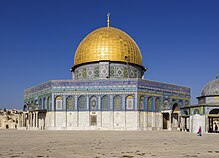A | B | C | D | E | F | G | H | CH | I | J | K | L | M | N | O | P | Q | R | S | T | U | V | W | X | Y | Z | 0 | 1 | 2 | 3 | 4 | 5 | 6 | 7 | 8 | 9

The holiest sites in Islam are located in the Arabian Peninsula.[2] While the significance of most places typically varies depending on the Islamic sect, there is a consensus across all mainstream branches of the religion that affirms two cities as having the highest degree of holiness, in descending order: Mecca, and Medina. Mecca's Al-Masjid al-Haram (including the Kaaba), Al-Masjid an-Nabawi in Medina are all revered by Muslims as sites of great importance.[1][3][4][5][6]
Within the Levant, both the Umayyad Mosque in the city of Damascus and the Ibrahimi Mosque in the city of Hebron have held interchangeable significance as the third and fourth-holiest Islamic sites for Sunni Muslims.[7]
After the consensus on the first two sites as well as further sites associated with the family of Muhammad, there is a divergence between Sunni Muslims and Shia Muslims on the designation of additional holy sites. For Sunnis, sites associated with the Rashidun, other Companions of Muhammad, and Biblical prophets hold a high level of significance (see holiest sites in Sunni Islam). For Shias, sites associated with the Imamah hold a high level of significance (see holiest sites in Shia Islam).[8] As part of the Hajj, the majority of Muslims also visit the sites of Mina, Mount Arafat, and Muzdalifah, in addition to the Kaaba.[9]
Hejaz
Hejaz is the region in the Arabian Peninsula where Mecca and Medina are located. It is where the Islamic prophet Muhammad was born and raised.[10]
The two holy cities of Islam, Mecca and Medina, are traditionally known as the Ḥaramayn, which is the dual form of ḥaram, thus meaning "The Two Sanctuaries".[11] They should not be confused with Jerusalem and Hebron, which were also called Haramain during the Mamluk period.[11] Another appellation of the Two Noble Sanctuaries is Ḥaramayn Ṭayyibayn.
Mecca

Mecca is considered the holiest city in Islam, as it is home to Islam's holiest site Kaaba in Al-Masjid Al-Ḥaram (The Sacred Mosque).[1][4] Only Muslims are allowed to enter this place.[12]
Kaaba
The Kaaba or Masjid al-Haram in Mecca, is the most sacred holy place of Islam and a Qibla of the Muslims, contains al-Bayt ul-Ma'mur spiritually above the Kaaba, contains the Maqam Ibrahim, Hateem, and the Al-Hajar-ul-Aswad which belonged in Jannah to Adam and Eve (Adam and Hawa). According to the Islamic tradition it was first built by the first prophet Adam, after Noah's Flood the flood of the prophet Nūḥ (Noah), it was then rebuilt by Abraham (ʾIbrāhīm) and his son Ishmael (Ismāʿīl), it has been rebuilt several times.
The area of Mecca, which includes Mount Arafah,[13] Mina and Muzdalifah, is important for the Ḥajj ('Pilgrimage'). As one of the Five Pillars of Islam,[14] every adult Muslim who is capable must perform the Hajj at least once in their lifetime.[15] Hajj is one of the largest annual Muslim gatherings in the world, second only to pilgrimages to the mosques of Husayn ibn Ali and his half-brother Abbas in Karbala, Iraq, with attendance reaching three million in 2012.[16]
Medina

Al-Masjid an-Nabawi is located in Medina, making the city the second-holiest site in Islam, after Mecca. Medina is the final place-of-residence of Muhammad, and where his qabr (grave) is located.[1] In addition to the Prophet's Mosque, the city has the mosques of Qubāʾ[17] and Al-Qiblatayn ("The Two Qiblahs").[18]
Masjid an-Nabawi
Masjid an-Nabawi or The Prophet's Mosque in Medina, contains the grave of Muhammad. The two companions Abu Bakr and Umar are also buried with Muhammad, the grave of Uthman in located in al-Baqi' cemetery located to the southeast of the Prophet's Mosque, while the grave of Ali is in Najaf. The grave of al-Hasan is also in al-Baqi', while al-Husayn is buried in Karbala.
Sunni Islam
In Sunni Islam, all sites which have been mentioned in the Hadith are holy to Sunni Muslims. The Kaaba is the holiest site, followed by the al-Masjid an-Nabawi (The Prophet's Mosque), al-Aqsa Mosque compound, and other sites mentioned in the Hadith, as well Umayyad Mosque, Ibrahimi Mosque.
Masjid al-Aqsa
Jerusalem's Temple Mount, called Masjid al-Aqṣā, was the first qibla of the Muslims before the Kaaba. According to tradition, Muhammad on the occasion of Isra' and Mi'raj led all the prophets and angels at the site, the site of the mosque built by Sulaymān, son of Dāwūd and king of the Israelites.
Others
Levant
Ash-Shaam[19] or the Levant[20] is a historical region that includes the cities of Jerusalem and Damascus.[19][21][22]
Jerusalem
The Al-Aqsa Mosque compound (Al-Masjid Al-Aqsa) in Jerusalem is the third holiest site in Islam. The compound is held in esteem by the entire Muslim community, due to its history as a place of worship by many prophets such as Ibrahim (Abraham),[4] Dawud (David), Sulaiman (Solomon), Ilyas (Elijah) and Isa (Jesus). The mosque has the capacity to accommodate in the region of 400,000 worshippers.[23] According to Islamic tradition, the Temple Mount served as the first qiblah (direction of prayer) for Muhammad and his Ummah, before the Kaaba in Mecca. Muslims believe that Muhammad was taken from Masjid al-Haram in Mecca, to visit Masjid al-Aqsa, where he led the prayer among the prophets, and was then taken to the heavens from the Foundation Stone[citation needed] (today part of the Dome of the Rock) in a single night in the year 620.[24]
The Qur'an mentions the Al-Aqsa Mosque only once in verse 1 of chapter no. 17[25] (Surah Al-Isra'),[26] as "the Farthest Mosque". Islamic scholars generally agree that this description refers to the Al-Aqsa Mosque, although Jerusalem is not mentioned in the Qur'an by name.[27]
Damascus
The Umayyad Mosque in Damascus is often considered the fourth holiest site in Islam.[7][28] The head of John the Baptist, revered in Islam as the prophet Yahya, is believed to be in a shrine inside the mosque, which also houses one of only four authorized original copies of the Quran. The Umayyad Mosque is also the place where Muslims believe the prophet Isa (Jesus) will return at the end of times, atop the "Minaret of Isa" of the mosque, during the time of a Fajr prayer. It is believed that prayers in the Umayyad mosque are considered to be equal to those offered in Jerusalem.[29]
The mosque also holds special importance to Shia Muslims since it contains shrines commemorating Husayn ibn Ali and the Ahl al-Bayt, made to walk there from Iraq, after the Battle of Karbala.[30] Furthermore, it was the place where they were imprisoned for 60 days.[31]
Hebron
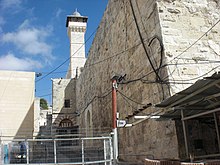
In Islamic belief, Hebron was where the Ibrahim (Abraham) settled. Within the city lies the Sanctuary of Abraham, the traditional burial site of the biblical Patriarchs and Matriarchs, and the Ibrahimi Mosque, built on top of the tomb to honor Abraham, is also often considered to be the fourth holiest in Islam.[32][33][34] Muslims believe that Muhammad visited Hebron on his nocturnal journey from Mecca to Jerusalem to stop by the tomb and pay his respects.[32] In the mosque in a small niche there is a left footprint, believed to be from Muhammad.[35][36]
Sinai Peninsula
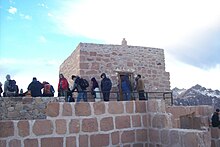
The Sinai Peninsula is associated with the prophets Harun (Aaron) and Musa (Moses).[37] In particular, numerous references to Mount Sinai exist in the Quran,[38][39] where it is called Ṭūr Saināʾ,[40] Ṭūr Sīnīn,[41] and aṭ-Ṭūr[42][43] and al-Jabal (both meaning "the Mount").[44] As for the adjacent Wād Ṭuwā (Valley of Tuwa), it is considered as being muqaddas[45][46] (sacred),[47][48] and a part of it is called Al-Buqʿah Al-Mubārakah ("The Blessed Place").[43]
Various other cites and mosques across the Islamic world are claimed to be fourth holiest site in Islam or among the holiest.
- The Great Mosque of Damascus is considered by some to be the fourth holiest site in Islam.[49][50]
- The city of Hebron in Palestine, which contains the Ibrahimi Mosque, is also considered by some to be the fourth holiest site in Islam.[51]
- The city of Kairouan, Tunisia, is considered by some to be the fourth holiest city in Islam after Mecca, Medina and Jerusalem.[52][53][54][55] Local tradition holds that seven pilgrimages to the Great Mosque of Kairouan equals one pilgrimage to Mecca.[56][57][58]
- The city of Bukhara in Uzbekistan (which is associated with Imam Al-Bukhari) is considered as a holy city,[59][60] also claimed by some to be the fourth holiest city in Islam.[61]
- The city of Harar in Ethiopia is considered by some to be the fourth holiest city in Islam.[62][63][64]
- The town of Chinguetti in Mauritania, whose libraries contain many ancient manuscripts, is claimed by some to be the seventh holiest city in Islam.[65][66]
Shia Islam
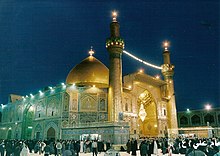
Overlap with other sects in Islam
Similar to Sunni Islam and other sects, the Holiest sites in Shia Islam are Mecca, followed by Medina.[67]
After these two sites, most importance is put upon the following sites according to Shia:
Imam Ali Mosque
Imam Ali Mosque in Najaf, Iraq, is the holiest site for Shia Muslims after the Holy Sites in Mecca and Medina. It holds the tomb of the first Shia Imam, Ali ibn Abi Talib, who was also the cousin and son-in-law of the Islamic prophet Muhammad. According to Shia belief, the tomb also contains the remains of the prophets Adam and Noah.[68]
The shrine's significance in Shia Islam is profound. Imam Ali is revered by all Muslims but by Shia in particular as a paragon of justice, knowledge, and piety. His burial site has thus become a symbol of Shia identity and faith. Every year, the shrine is visited by millions of pilgrims, with numbers peaking during the annual Arbaeen event, where estimates suggest over 20 million visitors.[69]
Historical Background
The Imam Ali Mosque has a rich history that dates back to the 7th century. Ali was buried in Najaf following his assassination in 661 AD. However, the location of his grave remained a closely guarded secret for many years due to political tensions. It wasn't until the Abbasid caliph Harun al-Rashid reportedly discovered the grave during a hunting expedition in the 8th century that a shrine was built at the site.[70]
Over the centuries, the shrine has undergone numerous renovations and expansions. The Buyid dynasty, in the 10th century, made significant contributions by building a large dome over the grave and adding other structures.[71] The Safavid dynasty in the 16th century also played a crucial role in further developing the site, adding ornate decorations, and expanding the mosque complex.[72]
Architecture and Structure
The Imam Ali Mosque is an architectural masterpiece. The shrine is distinguished by its golden dome and minarets, which are covered with approximately 7,777 tiles of gold. The complex also includes courtyards, prayer halls, and a museum. The central hall, where the tomb is located, is adorned with intricate mirror work, mosaics, and calligraphy.[73]
The mosque features a large courtyard, known as the Sahan, which is surrounded by arched colonnades. The main entrance, Bab al-Qibla, is an impressive gateway that leads directly to the inner sanctum. The interior is lavishly decorated with Persian carpets, chandeliers, and intricate stucco work, reflecting the rich artistic heritage of the region.[74]
Burials at the Shrine
In addition to Imam Ali, the shrine complex is the final resting place for several notable figures. Among them are many revered Shia scholars, jurists, and theologians. Some of the prominent figures buried here include:
- Sheikh Murtada Ansari, a leading Shia jurist of the 19th century.[75]
- Muhammad Baqir al-Sadr, a renowned Iraqi Shia cleric and philosopher.[76]
- Abu al-Qasim al-Khoei, one of the most influential Shia marjas of the 20th century.[77]
The shrine is also surrounded by a vast cemetery known as Wadi al-Salam, which is the largest cemetery in the world. It is believed that being buried near Imam Ali brings spiritual benefits, and many Shia Muslims request to be interred in this sacred ground.[78]
Pilgrimage and Religious Significance
The Imam Ali Mosque is a focal point for Shia pilgrimage. Every year, millions of devotees travel to Najaf to pay their respects, particularly during significant religious occasions such as the anniversaries of Ali's birth and martyrdom, as well as the Arbaeen pilgrimage. The Arbaeen pilgrimage marks the end of the 40-day mourning period for Imam Hussein, Ali's son, who was martyred at the Battle of Karbala.[79]
During Arbaeen, the number of visitors can exceed 20 million, making it one of the largest peaceful gatherings in the world. Pilgrims often travel on foot from various parts of Iraq and even from neighboring countries to participate in the commemorations.[80]
Modern Developments
In recent years, the Iraqi government and various Shia organizations have undertaken numerous projects to renovate and expand the shrine complex. These efforts aim to accommodate the growing number of pilgrims and to preserve the historical and religious heritage of the site. Enhancements include improved infrastructure, expanded facilities for pilgrims, and increased security measures to protect visitors.[81]
The Imam Ali Mosque stands not only as a place of worship but also as a symbol of Shia resilience and devotion. Its history, architecture, and the immense reverence it commands make it a central pillar of Shia Islam and a testament to the enduring legacy of Imam Ali.
Imam Husayn Shrine

Imam Husayn Shrine in Karbala, Iraq, contains the tomb of Husayn ibn Ali. The mosque stands on the site of the grave of Husayn ibn Ali, where he was martyred during the Battle of Karbala in 680.[82][83] Up to 20 million pilgrims visit the city for the anniversary of Hussein ibn Ali's death.[84] There are many Shia traditions which narrate the status of Karbala.
The Imam Husayn Shrine is a site of immense religious significance for Shia Muslims. It commemorates the martyrdom of Husayn ibn Ali, the grandson of the Prophet Muhammad, who was killed in the Battle of Karbala on the 10th of Muharram in the year 680 AD. This event is one of the most tragic and pivotal moments in Islamic history, especially for Shia Muslims, as it symbolizes the struggle against tyranny and injustice.
Historical Background
The Battle of Karbala was a defining moment in Islamic history. Husayn ibn Ali, along with his family and companions, was martyred by the forces of the Umayyad caliph Yazid I. The battle took place on the plains of Karbala, and Husayn’s stand against Yazid’s oppressive regime has since been revered as a symbol of resistance and martyrdom in Shia Islam.[85]
Following the martyrdom, the site of Husayn's grave became a place of pilgrimage. The first structure over his grave was constructed by the order of Mukhtar al-Thaqafi in the late 7th century.[86] Throughout the centuries, the shrine has been destroyed and rebuilt several times. Major renovations were carried out by various Islamic dynasties, including the Abbasids, Buyids, and Safavids.[87]
Architecture and Structure
The Imam Husayn Shrine is renowned for its stunning architecture and intricate decorations. The shrine complex includes a golden dome, several minarets, and expansive courtyards. The central dome is adorned with gold-plated tiles, and the interior features elaborate mirror work, mosaics, and calligraphy that depict verses from the Quran and sayings of the Prophet Muhammad and the Imams.[88]
The main courtyard, known as the Sahan, is surrounded by arched porticos and is a place where pilgrims gather to offer prayers and recite elegies. The shrine also includes a museum that houses artifacts related to Husayn ibn Ali and the Battle of Karbala, as well as a library with a vast collection of Islamic manuscripts and texts.[89]
Pilgrimage and Religious Significanceedit
The Imam Husayn Shrine is one of the most important pilgrimage sites in the world for Shia Muslims. The annual Arbaeen pilgrimage, which marks the end of the 40-day mourning period for Husayn ibn Ali, draws millions of visitors from around the world. During Arbaeen, pilgrims often walk long distances, sometimes covering hundreds of miles, to reach Karbala. This pilgrimage is considered an act of devotion and solidarity with the sacrifices made by Husayn and his companions.[90]
Besides Arbaeen, other significant occasions that draw large crowds to the shrine include Ashura, the day of Husayn's martyrdom, and the birthdays and martyrdom anniversaries of other Shia Imams. The shrine also plays a central role in the commemoration of various religious events and serves as a hub for religious learning and scholarship.[91]
Modern Developmentsedit
In recent years, the shrine has undergone extensive renovations and expansions to accommodate the growing number of pilgrims. These developments include the construction of new facilities for pilgrims, improved infrastructure, and enhanced security measures. Efforts have also been made to preserve the historical and architectural heritage of the shrine while ensuring that it can meet the needs of contemporary visitors.[92]
The Imam Husayn Shrine continues to be a beacon of faith, drawing millions of devotees who seek solace, inspiration, and a deeper connection to their religious heritage. It stands as a testament to the enduring legacy of Husayn ibn Ali and his unwavering stand for justice and righteousness.
Abbas Ibn Ali Shrineedit
The Abbas Ibn Ali Shrine in Karbala, Iraq, is the mausoleum of Abbas ibn Ali, who was the half-brother of Husayn ibn Ali and a key figure in the Battle of Karbala. Abbas is revered for his loyalty and bravery, and his shrine is one of the holiest sites for Shia Muslims, attracting millions of pilgrims, especially during the annual commemoration of Arba'een.[93]
Historical Backgroundedit
Abbas ibn Ali, also known as Abu al-Fadl, was a son of Ali ibn Abi Talib and a respected warrior known for his unwavering support of his brother Husayn. He played a crucial role in the Battle of Karbala, where he met his martyrdom while attempting to fetch water for the thirsty children and companions of Husayn. His sacrifice is deeply commemorated in Shia tradition, and his shrine stands as a symbol of devotion and courage.[94]
The construction of the shrine began in the early Islamic period, with significant contributions from various Islamic rulers. The earliest recorded construction was during the Abbasid Caliphate, with later renovations and expansions by the Safavid and Qajar dynasties.[95] The shrine has been rebuilt and restored multiple times due to natural disasters and political upheavals.
Architecture and Structureedit
The Abbas Ibn Ali Shrine is an architectural marvel, featuring a grand golden dome and two towering minarets, which are visible from miles away. The shrine complex includes several courtyards, prayer halls, and a museum. The central hall, where the tomb is located, is lavishly decorated with intricate tile work, mirror mosaics, and Arabic calligraphy depicting verses from the Quran and sayings of the Prophet Muhammad and the Imams.[96]
The shrine is surrounded by spacious courtyards that can accommodate the influx of pilgrims during major religious events. The main entrance, known as Bab al-Qibla, is an ornate gateway that leads to the inner sanctum. Inside, the walls are adorned with elaborate stucco and mirror work, reflecting the rich artistic heritage of the region.[97]
Religious Significanceedit
The Abbas Ibn Ali Shrine holds immense religious significance for Shia Muslims. Abbas ibn Ali is revered not only for his familial connection to Husayn but also for his virtues of loyalty, courage, and self-sacrifice. His shrine is a focal point of pilgrimage, particularly during the annual Arbaeen commemoration, which marks the end of the 40-day mourning period for Husayn ibn Ali.[98]
Pilgrims from around the world visit the shrine to pay their respects and seek intercession. The rituals performed at the shrine include recitations of elegies, lamentations, and the reenactment of the events of Karbala. These practices are deeply ingrained in Shia cultural and religious identity, symbolizing the eternal struggle against oppression and injustice.[99]
Pilgrimage and Cultural Impactedit
The shrine is a major destination for millions of pilgrims, especially during the Arbaeen pilgrimage. This event is one of the largest annual religious gatherings in the world, where devotees often walk from Najaf to Karbala as a sign of their devotion and solidarity with Abbas ibn Ali and the other martyrs of Karbala. The pilgrimage is marked by a profound sense of community and spiritual renewal.[100]
Beyond its religious significance, the shrine has a considerable cultural impact. It serves as a center for religious education, charitable activities, and social services. The surrounding area of Karbala has developed significantly to support the influx of pilgrims, with numerous facilities, accommodations, and services dedicated to catering to the needs of visitors.[101]
Modern Developmentsedit
In recent years, the shrine has seen extensive renovations and expansions. These efforts aim to preserve the historical and architectural integrity of the site while accommodating the increasing number of pilgrims. Modern amenities, improved infrastructure, and enhanced security measures have been introduced to ensure the safety and comfort of visitors.[102]
The Abbas Ibn Ali Shrine continues to be a beacon of faith and a testament to the enduring legacy of Abbas ibn Ali. It stands as a symbol of loyalty, bravery, and the eternal struggle for justice, drawing millions of devotees who seek solace and inspiration from his exemplary life.
Al-Askari Shrineedit
The Al-Askari Shrine in Samarrah, Iraq, contains the tombs of the tenth and eleventh Shia Imams, Ali al-Hadi and Hasan al-Askari. The shrine is a significant site for Shia pilgrimage and has faced several attacks, most notably in 2006 and 2007, causing extensive damage.[103]
Kadhimayn Shrineedit
The Kadhimayn Shrine in Baghdad, Iraq, houses the tombs of the seventh and ninth Shia Imams, Musa al-Kadhim and Muhammad al-Jawad as well as multiple notable scholars from Shia History. It is an important pilgrimage site, and the surrounding area, Kadhimayn, is named after these Imams.[104]
Jannat al-Baqiedit
Jannat al-Baqi in Medina, Saudi Arabia, is a cemetery that holds the graves of several family members and companions of the Prophet Muhammad. Among them are the four Shia Imams: Hasan ibn Ali, Ali ibn Husayn, Muhammad al-Baqir, and Jafar al-Sadiq. The cemetery is a revered site for Shia Muslims.[105]
Imam Reza Shrineedit
Imam Reza shrine, located in Mashhad, Iran, contains the tomb of Ali al-Rida, the eighth Imam of Shia Islam. It is the largest mosque in the world by area. The complex is a tourism center in Iran[106][107] with 25 million Shias visiting the shrine each year.[108]
Masjid al-Kufaedit
Masjid al-Kufa, located in Kufa, Iraq, is one of the oldest and holiest mosques in the world. It holds great significance for Shia Muslims due to its historical and religious importance.
Historical Significanceedit
Masjid al-Kufa is believed to have been built in the 7th century. It is one of the four major mosques that Shia Muslims consider to be significant, the others being the Kaaba, Al-Aqsa Mosque, and the Great Mosque of Quba. According to Shia tradition, the mosque was constructed by Adam, with subsequent renovations by Nuh (Noah), Ibrahim (Abraham), and Ismail (Ishmael).
Religious Importanceedit
Masjid al-Kufa holds immense religious significance for Shia Muslims. It was the place where Ali ibn Abi Talib, the first Shia Imam, and the fourth caliph in Sunni Islam, used to lead prayers and deliver sermons. The mosque is also the site where he was struck with a fatal blow by Ibn Muljam during the month of Ramadan in 661 CE.[109]
Key Locations Within the Mosqueedit
- Mihrab of Imam Ali: The mihrab marks the spot where Imam Ali was fatally struck while praying.
- Maqam of Ibrahim: It is believed that this is the place where Prophet Ibrahim prayed.
- Maqam of Muslim ibn Aqil: This spot commemorates Muslim ibn Aqil, the cousin of Imam Husayn, who was sent to Kufa by Husayn as his emissary and was martyred here.
- Maqam of Hani ibn Urwa: Hani ibn Urwa was a supporter of Muslim ibn Aqil and was martyred alongside him.
- House of Imam Ali: Adjacent to the mosque is the house of Imam Ali, which is now a site of pilgrimage.
Pilgrimageedit
The mosque is a significant pilgrimage site for Shia Muslims, especially during the anniversary of Imam Ali's death and other important Islamic events. Pilgrims visit the mosque to pay their respects, pray, and reflect on its historical and spiritual significance.[110][111]
Othersedit
Fatima Masumeh Shrineedit
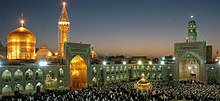
The city of Qom in Iran contains the tomb of Fātimah bint Mūsā, sister of the eighth Twelver Shi'ite Imam, Ali al-Rida. The shrine has attracted to itself dozens of seminaries and religious schools.
Masjid Sahlaedit
Masjid Sahla in Kufa, Iraq, is an ancient mosque believed to have been built on the site where several prophets, including Idris (Enoch), Ibrahim (Abraham), and Khadir (al-Khidr), prayed. It is also associated with the future return of the Mahdi according to Shia belief.[113]
Masjid Hananaedit
Masjid Hanana in Najaf, Iraq, is believed to be a site where the head of Husayn ibn Ali rested on its way to Kufa after the Battle of Karbala. It is a site of reverence and pilgrimage for Shia Muslims.[114]
Baladedit
Balad, Iraq, is home to the Sayid Muhammad Shrine, dedicated to Sayid Muhammad ibn Ali al-Hadi, the son of the tenth Shia Imam, Ali al-Hadi. It is an important pilgrimage site, especially for those who visit the Samarrah shrines.[115]
Mada'inedit
Mada'in, Iraq, is known for its historic significance and the tomb of Salman the Persian, a companion of the Prophet Muhammad and revered figure in Shia Islam. The site attracts many pilgrims annually.[116]
Jamkaran Mosque in Qom, Iran, is a popular pilgrimage site for Shia Muslims.
Shāh Cherāgh in Shiraz, Iran, houses the mausoleums of the two sons of Musa al-Kazim, the seventh Imam in Twelver Shia Islam and a descendant of Muhammad.
S̲h̲āh ʿAbd al-ʿAẓīm Shrine in Rey, Iran, contains the tomb of ʿAbd al-ʿAẓīm al-Ḥasanī, a descendant of Ḥasan ibn ‘Alī and a companion of Muhammad al-Taqī.
Zdroj:https://en.wikipedia.org?pojem=Holiest_sites_in_Islam
>Text je dostupný pod licencí Creative Commons Uveďte autora – Zachovejte licenci, případně za dalších podmínek. Podrobnosti naleznete na stránce Podmínky užití.
Text je dostupný za podmienok Creative
Commons Attribution/Share-Alike License 3.0 Unported; prípadne za ďalších
podmienok.
Podrobnejšie informácie nájdete na stránke Podmienky
použitia.
